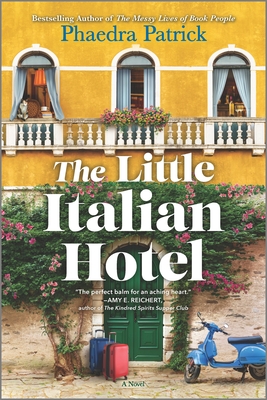 The Little Italian Hotel by Phaedra Patrick
The Little Italian Hotel by Phaedra Patrick Format: eARC
Source: supplied by publisher via Edelweiss
Formats available: hardcover, large print, paperback, ebook, audiobook
Genres: relationship fiction, travel fiction, women's fiction
Pages: 320
Published by Park Row on June 6, 2023
Purchasing Info: Author's Website, Publisher's Website, Amazon, Barnes & Noble, Kobo, Bookshop.org, Better World Books
Goodreads
When a relationship expert’s own marriage falls apart, she invites four strangers to Italy for a vacation of healing and second chances in this uplifting new novel from the author of
The Messy Lives of Book People
.
Ginny Splinter, acclaimed radio host and advice expert, prides herself on knowing what’s best for others. So she’s sure her husband, Adrian, will love the special trip to Italy she’s planned for their twenty-fifth wedding anniversary. But when Ginny presents the gift to Adrian, he surprises her with his own very different plan—a divorce.
Beside herself with heartache, Ginny impulsively invites four heartbroken listeners to join her in Italy instead while live on air. From hiking the hills of Bologna to riding a gondola in Venice to sharing stories around the dining table of the little Italian hotel, Ginny and her newfound company embark on a vacation of healing.
However, when Adrian starts to rethink their relationship, Ginny must decide whether to commit to her marriage or start afresh, alone. And an unexpected stranger may hold the key to a very different future… Sunny, tender and brimming with charm, The Little Italian Hotel explores marriage, identity and reclaiming the present moment—even if it means leaving the past behind.
Look for Phaedra Patrick’s previous charming bestsellers! The Curious Charms of Arthur Pepper Rise and Shine, Benedict Stone The Library of Lost and Found The Secrets of Love Story BridgeThe Messy Lives of Book People
My Review:
There are a slew of really good reasons why doctors make the worst patients and lawyers who represent themselves have fools for clients. In both cases the practitioner, no matter how successful they are in their profession, are generally incapable of having the emotional distance necessary to do that job well when it comes to their own lives.
The same thing is true of therapists – and undoubtedly advice columnists. It’s easy to give advice to other people, but hard to see one’s own problems – even when they are staring you in the face.
And that’s where Ginny Splinter’s journey to The Little Italian Hotel begins, when a caller into her radio talk show/advice column tells her that her so-called ‘perfect life’ is anything but. A truth that Ginny has been trying to keep herself from looking into for a whole lot longer than she is willing to admit. Even to herself. Especially to herself.
Ginny’s marriage has, not a communications problem, but a communications chasm. She keeps trying to patch it over, while her husband Adrian has just detached himself from it and from her. Neither of them is innocent. Neither of them is particularly guilty – at least not yet – either.
Although there’s a vat of acid waiting for Adrian because he IS a real douche about the whole thing. But that’s attitude and not adultery – at least not yet.
When the feces hits the oscillating device Ginny is left with an empty house, a hole in her heart, an adult daughter she’s not ready to rip the emotional bandage off of just yet – and an over-the-top, romantic-to-the-max, totally non-refundable, three week holiday in Italy that she has no idea what to do with.
Her solution to that one practical part of her dilemma sits right on that fine line between genius and insanity – and could tip either way at a moment’s notice. She can’t get her money back, but she can switch the trip from expensive and uber-romantic for two to a much less expensive family-run small-town pensione for five. Since the trip is already paid for, she invites four of her listeners to come along with her on a trip to hopefully heal all of their broken hearts.
She has no plan, no itinerary, and no previous knowledge of ANY of her new traveling companions. It’s either going to be three weeks of wonder, three weeks of limbo, or three weeks of hell on Earth.
But it just might work. And it will absolutely, positively (or perhaps negatively) be an adventure!
Escape Rating B: The thing that struck me about The Little Italian Hotel, once we start getting to know the whole ensemble, is that the story doesn’t give any one kind of grief more weight than any other. And that was terrific because of the way it validates all the feelings in ways that we don’t often see jumbled together in one story.
While the group wasn’t as diverse as it could have or possibly should have been, it did represent a spectrum of the different ways that life can fall completely apart and just how hard it is to get out of your own head to get yourself on a positive trajectory after the fact.
Ginny, as is obvious from the blurb, is 50 and is looking at a marriage that wasn’t nearly as ‘perfect’ as she thought it was. A revelation that will change the course of the rest of her life, whether they patch things back together or go their separate ways. And I loved that even though some of the blurbs refer to this as a romance, it really isn’t. This is Ginny’s journey to finally learning what she wants out of her life for her ownself and that’s lovely.
Her travel companions range from 20 something Eric who has lost his best friend, to 80 something Edna who lost her husband and special needs daughter decades ago and has just sold her house full of memories to move to a retirement village. The griefs and losses weighing down 30 something Curtis and 40 something Heather are just as heartbreaking and completely different from each other’s and everyone else’s.
What makes the story fun is that it is a journey of discovery for everyone, including the pensione’s owner and his college-age daughter. The group as a whole grows together, sometimes drifts apart, drives each other crazy and individually and collectively goes places both emotionally and physically they never thought they’d go.
And wouldn’t have been able or willing to go alone.
This is also a bit of a slice-of-life/slice-out-of-life story, and like life itself, it doesn’t really come to a definitive ending, at least not for Ginny herself. She decides to continue her journey of discovery, but not by either traveling around the world or falling in love as happens in Eat, Pray, Love. (The whole thing is a bit of Eat, Pray, Love mixed with The Best Exotic Marigold Hotel, making it charming all the way around.) But it’s not quite a happy ever after, and it’s not exactly a romance, and it’s just a tiny bit equivocal in its finish that is not exactly an ending.
And isn’t that just like life?

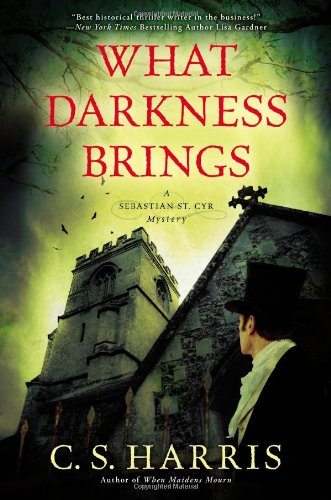 What Darkness Brings (Sebastian St. Cyr, #8) by
What Darkness Brings (Sebastian St. Cyr, #8) by 
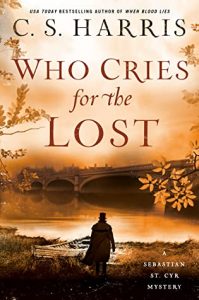 Escape Rating A: It’s not much of a surprise that after
Escape Rating A: It’s not much of a surprise that after 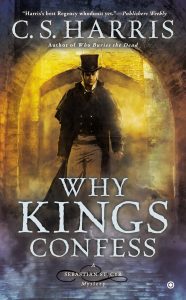 The way the murder, the theft plot and the real history branched and intertwined made this entry in the series one hell of a wild ride, while still tying up loose ends from previous entries and opening up entirely new fields of questions for future books in the series – some of which have admittedly been answered by the point where the series as a whole rests – hopefully temporarily – after
The way the murder, the theft plot and the real history branched and intertwined made this entry in the series one hell of a wild ride, while still tying up loose ends from previous entries and opening up entirely new fields of questions for future books in the series – some of which have admittedly been answered by the point where the series as a whole rests – hopefully temporarily – after 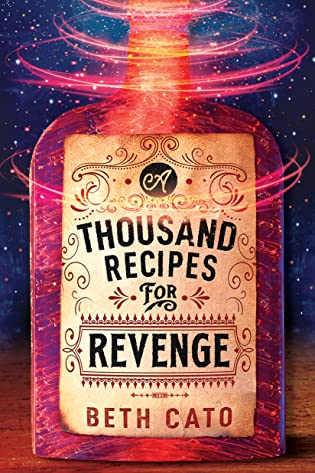 A Thousand Recipes for Revenge by
A Thousand Recipes for Revenge by  Escape Rating A+: I picked this up because I was looking for something else with magical cookery after
Escape Rating A+: I picked this up because I was looking for something else with magical cookery after 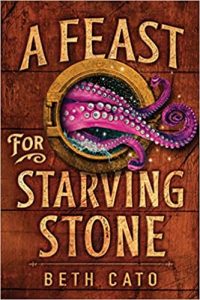 Ada and Solenn give readers two heroines to route for, as this is both Ada’s story of picking up the pieces of the life she left behind and Solenn’s coming of age story and both are fantastic. The world’s setup at first seems fairly standard epic fantasy and then goes to places that are fresh (if occasionally rotting) and new and unexpected. There are bits of Bujold’s
Ada and Solenn give readers two heroines to route for, as this is both Ada’s story of picking up the pieces of the life she left behind and Solenn’s coming of age story and both are fantastic. The world’s setup at first seems fairly standard epic fantasy and then goes to places that are fresh (if occasionally rotting) and new and unexpected. There are bits of Bujold’s 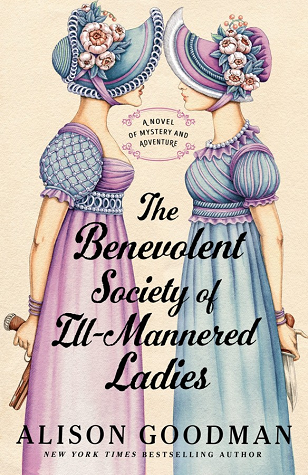 The Benevolent Society of Ill-Mannered Ladies (The Ill-Mannered Ladies, #1) by
The Benevolent Society of Ill-Mannered Ladies (The Ill-Mannered Ladies, #1) by 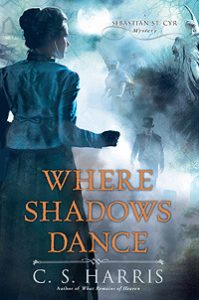 Both the Colebrook sisters and St. Cyr are conducting their investigations during the Regency period, in this book specifically 1812 – which is also the year in which books 4 through 8 of the St. Cyr series (
Both the Colebrook sisters and St. Cyr are conducting their investigations during the Regency period, in this book specifically 1812 – which is also the year in which books 4 through 8 of the St. Cyr series (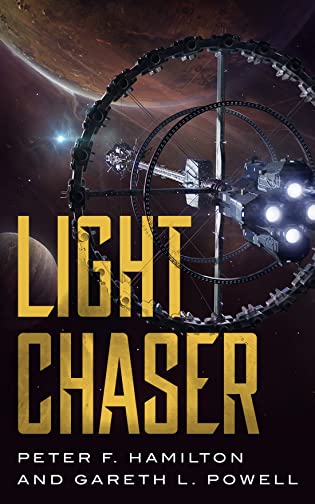 Light Chaser by
Light Chaser by 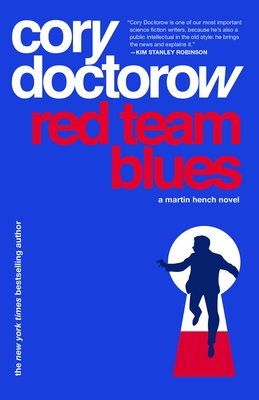 Red Team Blues (Martin Hench) by
Red Team Blues (Martin Hench) by  Dear Chrysanthemums: A Novel in Stories by
Dear Chrysanthemums: A Novel in Stories by  You Are Here by
You Are Here by  The Piano Tuner by
The Piano Tuner by 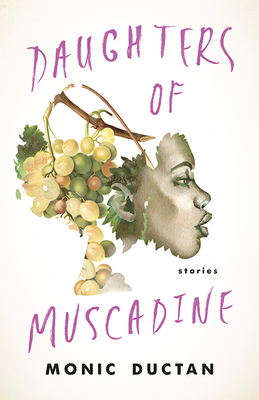 Daughters of Muscadine by Monic Ductan
Daughters of Muscadine by Monic Ductan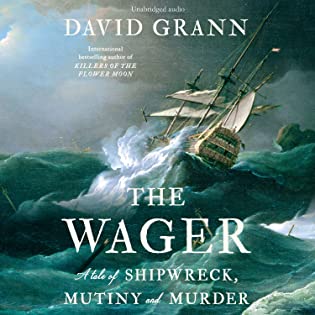 The Wager: A Tale of Shipwreck, Mutiny and Murder by
The Wager: A Tale of Shipwreck, Mutiny and Murder by 